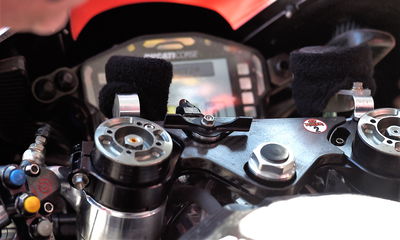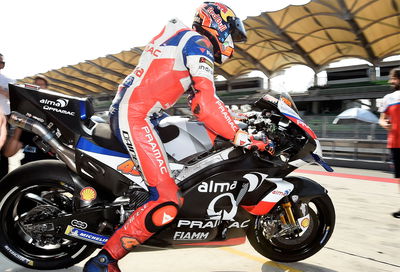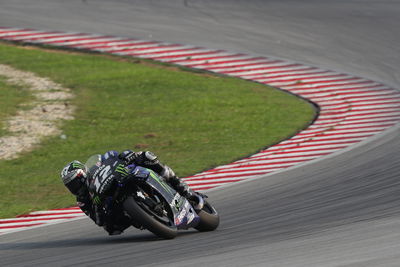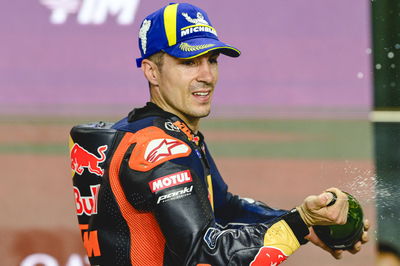Ducati's mystery switch…
UPDATE: We can now see that the switch does indeed lower the rear of the bike for the race start...
The horizontal lines on the barrier clearly show the rear of the bike squat down when the holeshot device is activated. https://t.co/TclxRqEGbe

UPDATE: We can now see that the switch does indeed lower the rear of the bike for the race start...
The horizontal lines on the barrier clearly show the rear of the bike squat down when the holeshot device is activated. https://t.co/TclxRqEGbe
— Peter McLaren (@McLarenMotoGP) March 9, 2019
It's not clear exactly how long it's been there, but a new wingnut-style switch was spotted on the triple clamp between the front forks on the Desmosedici GP19s at this week's Sepang MotoGP test.
Unsurprisingly, Ducati would not confirm what the switch is for, but the popular rumour was that it operates some form of 'holeshot device'.
In motocross/supercross a 'holeshot (first to turn one) device' is basically a kind of clip that holds the front fork in a semi-compressed position for the start of the race, therefore helping to reduce wheelies by putting more weight on the front.
When the rider brakes for turn one, the clip releases and the suspension works as normal thereafter.
It certainly isn't a crazy idea to use something similar in MotoGP, experienced Honda crew chief Chris Pike tweeting that they had used such a device in BSB a decade ago:
Old school tech, that was on @OfficialBSB Honda’s back in 2006/7 I think I remember correctly, that out of 26 races in 2007 JR and Kiyo got the hole shot in 25, 19-6 to JR.
— _Chris (@cp23109) February 7, 2019
While in motocross the rider or a mechanic has to compress the forks by hand, with the bike at a standstill, the holeshot system used on the factory Hondas in BSB locked the forks down when the rider braked approaching his grid slot (thereby compressing the front suspension).
Launch control only controls the engine, hole shot devices physically keep the centre of gravity lower so it is more difficult to wheelie off the start. Therefore allowing you to apply more power with the launch control strategy.
— _Chris (@cp23109) February 9, 2019
The HRC one never malfunctioned, the slightest touch of the front wheel on the ground released it
— _Chris (@cp23109) February 9, 2019
Slip is only an issue in the wet for a motorcycle race start. The pitch generated by the clutch release makes wheelie the main issue to control in a start.
— _Chris (@cp23109) February 10, 2019
I deleted my original answer because I wasn’t happy with it Clutch release is important to be aggressive to get an initial ‘jump’, after that you try to keep rpm high so you are over the peak torque point to reduce wheelie tendency. A low c.o.g. is always better for launch
— _Chris (@cp23109) February 10, 2019
But is that actually what the Ducati switch is for?
The switch is certainly large enough to be operated by the rider while wearing gloves on the bike and is mechanical, rather than electrical, meaning it could legally change the suspension (electronic changes being banned):
MotoGP rules: Suspension and Dampers
'Electric/electronic controlled suspension, ride height and steering damper systems are not allowed. Adjustments to the suspension and steering damper systems may only be made by manual human inputs and mechanical/hydraulic adjusters.'
There is a device on the forks to help with the starts?
"I also hear some media say about this… I don't know if that is the work [it does]."
So what is 'the work' [it does]?
"I don't know… [Ask the] engineers, they know!"
Did you use it today?
"Yes."
Did it work?
"Ummm… I don't know! [laughs]'
But as word spread around the paddock, and with more photos emerging, a closer look at the cable running from the switch seemed to suggest it was going towards the back of the bike, rather than the front.
Assuming the cable direction is not a decoy, theory number two was that the switch might therefore lock the rear shock at the start of a race, to prevent it compressing as the bike accelerates, again to try and stop the front wheel lifting.
However, the front fork would be more effective, assuming it's a holeshot device.
Why might a holeshot device appear now?
As with the increase in the importance of wings since the 'simpler' single ECU in 2016, keeping the front wheel down at the start means less use of power-sapping anti-wheelie electronics.
But there was also a third theory: That the switch is not actually linked to the suspension at all and instead to the 'salad box' at the back of the bike, to engage or disengage whatever is inside. A mass damper is most commonly rumoured, but has never been proven.
The 'salad box' seems to grow larger every year, suggesting that whatever it does, works...
Either way, the size and location of the new switch suggests it is used by the rider while the bike is in motion, but not during a race/fast lap, since a hand would need to be taken off the handlebar.

As if all that technical speculation wasn't enough to keep its rivals and the media guessing, Ducati also unveiled a new fairing at Sepang and tried the rear brake 'torque bar' for only the second time in public.
And of course, if HRC was successfully using a holeshot device in BSB back in 2006-2007, it's hard to believe they haven’t at least tried such a system on the RCV…












